
Studies of Invasive Species, Restoration, Plant Ecology, and Remote SensingNorthern Prairie Wildlife Research Center |
 |
Wildlife habitat has been a research focus at Northern Prairie Wildlife Research Center since 1965. Recent studies reflect the growing importance of invasive species to habitat management and the increased development of remote sensing technologies to better evaluate habitat at a landscape scale. Restoration ecology is also gaining prominence as a focus of more basic research.

The Role of Yellow Sweetclover (Melilotus officinalis) in Successional Processes at Badlands National Park, South Dakota -- Yellow sweetclover, while valued as a forage crop for livestock and honeybees, has become invasive in natural areas throughout the northern Great Plains. Its status as a nitrogen-fixer, along with its abundance, makes it especially troubling in early successional landscapes such as those at Badlands National Park. The objective of this study is to assess the role of yellow sweetclover in successional processes at Badlands National Park. In particular, we ask (1) if native plants are nitrogen-limited, (2) if sweetclover changes the amount of nitrogen available to native plants, and (3) if processes differ in the early successional Badlands sparse vegetation compared with the Western Wheatgrass vegetation type, which occurs on more developed soils. Contact: dlarson@biosci.umn.edu
Plant-Soil Feedback as a Driver of Plant Invasions of Mixed-Grass Prairie -- The overall goal is to understand the role of arbuscular mycorrhizal fungi (AMF) in the invasion process and to assess the potential utility of AMF in planned restorations. Using greenhouse experiments, we have demonstrated that leafy spurge (Euphorbia esula), crested wheatgrass (Agropyron cristatum), and smooth brome (Bromus inermis) change soil properties such that they are favored over certain native prairie species. AMF are at least partly responsible for this soil transformation. How can this information be used during habitat restoration to successfully plant native species without reinvasion of the exotic? Ongoing studies in mesocosms and in the greenhouse address this question. Contact: dlarson@biosci.umn.edu
Biological Control of Leafy Spurge in Theodore Roosevelt National Park, North Dakota -- The dynamics of leafy spurge are controlled by factors other than interactions with its biological control agents. Spurge density changes were not found to correlate with A. nigriscutis density during this study. Relationships in the data support the interpretation that A. lacertosa populations are not controlled by spurge densities while A. nigriscutis populations tracked spurge population densities. Studies that look directly at larval density and damage to roots will be necessary to verify that A. lacertosa is the more effective control agent, as these analyses suggest. Observed negative associations between A. lacertosa and A. nigriscutis suggest the need for detailed studies of interspecific interaction between the two species. Contact: dlarson@biosci.umn.edu
Chemical Control of Leafy Spurge at Theodore Roosevelt National Park, North Dakota -- A single application of herbicide does not provide satisfactory control of well-established leafy spurge infestations. However, the generally small effects on native diversity and biomass that resulted from our experimental imazapic application are encouraging. In addition, leafy spurge stem counts were lower in both imazapic and picloram/2,4-D plots than in those subject to flea beetle herbivory alone. Nonetheless, the decreased effectiveness of A. lacertosa where herbicides were applied suggests that herbicide use and biological control may work at cross-purposes, at least under some circumstances. Research aimed at understanding at what levels resources become limiting to flea beetle populations, and the consequences for interactions among the flea beetle species, is necessary to fine-tune the timing of herbicide application when a large investment in biological control has been made. Contact: dlarson@biosci.umn.edu
Experimental Treatment of Cirsium arvense at Lacreek and Lake Andes and of Euphorbia esula at Arrowwood and Tewaukon National Wildlife Refuges -- Nutrient manipulations are an emerging approach to invasive plant management. As an amendment to traditional herbicide and biological control techniques, nutrient manipulation may serve to weaken the invasive plants (which are often poor competitors for nutrients) and change the competitive balance between weeds and late-seral stage natives. Experimental studies at wildlife refuges in North and South Dakota (1998-2003) tested the hypothesis that carbon amendments (that reduce available nitrogen) and interseeding with competitive warm-season grasses, in the presence of herbivory by biocontrol insects, will result in less robust stands of leafy spurge and Canada thistle and greater recovery of native prairie grasses. We found very few biocontrol insects feeding on Canada thistle, and although density of thistle is correlated with nitrogen availability on a landscape scale, we found little response at more local scales. Leafy spurge, on the other hand, has a well established flea beetle population that has caused some decline in density of spurge. We have found little response to our nitrogen manipulations, but will continue long-term monitoring. Contact: dlarson@biosci.umn.edu
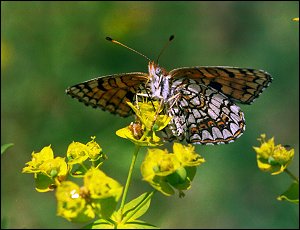
Pollen Transfer in an Invaded Prairie Plant Community -- Invasive plants with large flowering displays can compete with native plants for pollinator services, often to the detriment of native plant fitness. What is not yet clear is whether the change in pollinator services is due to the change in the resource landscape—i.e., more foreign pollen in the neighborhood, thus more foreign pollen on stigmas—or a change in the pollinator community that visits native plants to fewer or less efficient pollinators. The presence of leafy spurge within 100m of a native population had a clear influence on the amount of conspecific pollen on stigmas of actinomorphic, but not zygomorphic, flowers. We found no evidence that this pollen deficit was due to the sharing of pollinators, however, since leafy spurge was primarily visited by flies, which, with the exception of L. lewisii, rarely visited native flowers. Furthermore, we rarely found leafy spurge pollen on stigmas of native plants. Rather, our data suggest that bees, and in particular those in the family Halictidae, were less frequent visitors to native flowers when leafy spurge occurred nearby. Contact: dlarson@biosci.umn.edu
Habitat Characteristics and Invasibility -- Diverse habitats are thought to be less invasible, yet recent evidence indicates that invasibility is determined by multiple factors. Preliminary results from this study suggest that habitat invasibility should be assessed as the mass dominance, not total number or numerical abundance of invasives. Accordingly, the control factors of invasibility should also be biomass or dominance of natives or residents, not their numbers. Invasibility is the highest when the existing biomass is the lowest (relative to the full range of biomass values). Also, habitat invasibility changes over time, especially during succession: in early stages it involves positive relations, while in late stage, negative relations exist. Scientists and managers must work together to better understand what invasibility and invasiveness really mean and how to measure them and to ultimate distinctions between exotics and invasives. For better control and management, future research should focus more on the mass dominance of a few truly invasive species rather than total number of exotics in a habitat. Contact: qguo@usgs.gov
Integrated Geographic and Ecological Research for Identifying Potential Habitats and Predicting Future Spreading of Selected Invasives -- Scientists at NPWRC and EROS Data Center are collaborating with China's State Bureau of Surveying and Mapping to develop predictions of the potential distribution of selected invasive plants from China using remote sensing, GIS, and a variety of modeling techniques. Eastern Asia and North America share a wide range of similar environments and related biota, which may result in each region being more susceptible to the immigrant species from the other region than from many other parts of the world. Transpacific exchanges of alien plants and animals are increasing markedly as commerce and travel increase. As a result, an unknown number of accidental and deliberate immigrant species have and will arrive in both regions; some of these alien species will form invasives. Triadica sebifera L., Chinese tallow, the first of a several plants we are investigating, is a major threat to key native plant communities in the Southeast and is one of the most significant exotic invasive plants of Chinese origin in the U.S. Uncertainty remains regarding its potential to colonize inland habitats and cause further ecological and economic damage. As a first step in generating predictive models of potential T. sebifera distribution, we are developing a current distribution database and map of the species in the U.S. A database of presence/absence point information has been developed. In addition, we are currently making efforts to promote effective international communication, collaboration, and cooperation between ecologists, policy-makers, and quarantine officers in both Eastern Asia and North America. Contact: qguo@usgs.gov
Inventory of the Distribution and Abundance of Invasive Non-indigenous Plants and Rare Plants at Two Riverine Parks -- National Park Service park managers require baseline data on existing plant communities in their parks as part of their Inventory and Monitoring Program. In cooperation with the National Park Service Cooperative Ecosystems Study Unit at the University of Minnesota, we have coordinated the compilation of existing data on rare and invasive plants along the Mississippi National River Recreation Area and the St. Croix National Scenic River. We also have designed field surveys to assess the distribution and abundance of invasive species along these rivers with field surveys scheduled in the summer of 2004. Contact: dlarson@biosci.umn.edu

Horse Trails as Pathways of Exotic Species Invasions at Ozark National Scenic Riverways (OZAR) -- This two-year research project investigated exotic species frequency, cover and richness along horse trails, abandoned roads, and undisturbed sites in six native vegetation community types in OZAR. Horse trail sites supported a greater frequency and variety of exotic plants, most of which occurred only along horse trails. Management decisions can be tailored to focus on these pathways. Contact: esther_stroh@usgs.gov
Native Weeds and Exotic Plants: Relationships to Disturbance in Mixed-grass Prairie -- The objective of this study was to characterize and compare exotic and native weedy plant occurrence in and near three classes of disturbance—digging by prairie dogs, paved or gravel roads, and constructed trails—in three geographically separate national park units. There were differences both in the susceptibility of the disturbance classes to invasion and in the distributions of native weeds and exotic species among the disturbance classes. Both exotic and native weedy species richness were greatest in prairie dog towns and community composition there differed most from undisturbed areas. Exotic species were more likely to thrive near roadways, where native weedy species were infrequently encountered. Exotic species were more likely to have spread beyond the disturbed areas into native prairie than were weedy native species. The response of individual exotic plant species to the three types of disturbance was less consistent than that of native weedy species across the three park units. Contact: dlarson@biosci.umn.edu
Improving Native Seed Mix for Revegetating Disturbed Lands -- Whenever an anthropogenic force, such as road-building or installing a pipeline, causes soil disturbance in a national park, revegetation is necessary. We are evaluating the success of previous efforts to revegetate disturbed areas at Wind Cave National Park. Results will be used to develop and compare the success of a variety of native seed mixtures designed to improve upon the limited success of the past. Contact: asymstad@usgs.gov

Native Prairie Grassland Restoration: A Cross-site, Experimental Study -- The conversion of native grassland to cropland to facilitate cultivation was an important part of agricultural development in the northern U.S. prairies. Today, however, grasslands are considered one of the most imperiled ecosystems in the United States. This project focuses on basic restoration questions and will provide information to broaden our knowledge of how to restore native habitats and evaluate success of our efforts. Field experiments are currently underway at four North Dakota sites (Lostwood NWR, Devils Lake NWR, Jamestown, and Sheyenne National Grassland) to investigate effects of number of species planted on productivity and diversity of planted species, and resistance of the planting to biological invasion. Contact: terry_shaffer@usgs.gov
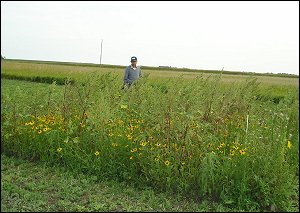
Riparian Willow Restoration Along the Illinois River at Arapaho NWR, Colorado -- Riparian willow communities provide important habitat for a diversity of wildlife, including neotropical migratory birds and native herbivores (e.g., moose, elk). However, sparse and discontinuous stands often are of low value and indicate little natural regeneration. Likely causes include historical clearing, reduced streamflow from water diversion, channel incision, and elevated levels of herbivory. The goal of this study is to investigate the efficacy of different restoration activities at Arapaho NWR by quantifying the effects of alternative management actions on riparian willow communities and use this information to provide the refuge staff with a set of management tools with known effectiveness under different circumstances. This study is being led by scientists in the Ecosystem Dynamics Program located at the Fort Collins Science Center in collaboration with Northern Prairie Wildlife Research Center. Contact: murray_laubhan@usgs.gov
Effect of Grazing on Plant Community Composition and Structure at Scott's Bluff National Monument -- This pilot study will compare the composition and structure of plant communities within Scott's Bluff National Monument, which has had no grazers since the 1940's or earlier, to moderately grazed areas outside the park. The goal of this study is to determine whether further investigation into the possibility of reintroducing native ungulate grazers in small prairie parks in the Northern Great Plains is warranted from the standpoint of plant community health. Contact: asymstad@usgs.gov
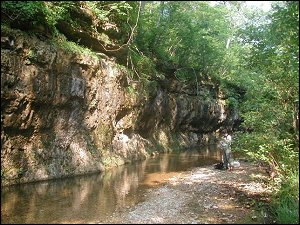
Microclimate Habitat Characterization and Population Demographics of Three Boreal Relict Plant Species -- Relic plants are locally rare species existing far from the core of their ranges. Boreal species that occur far south of their typical ranges are assumed to have migrated south during the Pleistocene, but as climate warmed, their distributions mostly moved northward. Climate change presents a threat to relict plant populations because changes to microclimates critical for their persistence could result in local extirpation. This study examined microhabitat characterizations of three boreal relict plant species in Ozark National Scenic Riverways, Missouri. Contact: esther_stroh@usgs.gov

Evaluating the Impacts of White-tailed Deer on Vegetation Within Pea Ridge National Military Park, Arkansas -- Browsing by white-tailed deer (Odocoileus virginianus) is the most significant natural resource issue at Pea Ridge National Military Park (PERI). Evidence of over-browsing by deer within the park includes lack of hardwood regeneration and absence of a shrub layer in forested areas, hindering the ability of PERI managers to maintain the park in a historically accurate condition. This study is the first at PERI to systematically examine park-wide effects of deer browse on plant communities. Results from this study will be used by park managers for a deer herd management plan and for restoration planning of forested communities. Contact: kgrabner@usgs.gov

Integrating Fuel and Forest Management: Developing Prescriptions for the Central Hardwoods -- The oak dominated forests, woodlands, and savannas of eastern North America have evolved under the influence of fire for thousands of years. In the Ozarks of southern Missouri, fire exclusion and timber harvests in the past 50-100 years have increased fuel loads and changed vegetation structure. Very little information is available on fuel loads and fire behavior in the Ozarks, even though fire is being used to restore certain forest communities. This study quantifies fuel loading, fire behavior, and the cost effectiveness of three fuel reduction treatments (prescribed fire with overstory thinning, prescribed fire alone, and a no burn no harvest control) herbaceous and woody species composition and structure. Contact: kgrabner@usgs.gov
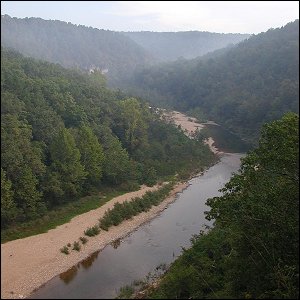
Mapping Vegetation Communities in Ozark National Scenic Riverways -- This collaborative project with the University of Missouri and the Missouri Department of Conservation will classify and map vegetation communities of Ozark National Scenic Riverways (OZAR) in southern Missouri. OZAR is located in one of the largest contiguous blocks of forest in the Midwest and contains a wide variety of terrestrial communities, including numerous upland forest types, glades, fens, bottomland forests, cliffs and caves. We developed a vegetation community classification field key that describes 75 community types in the study area. Of these, 42 are natural/semi-natural communities, and 33 are disturbed or altered communities. We used the field key during summer 2003 to classify communities in 453 sampling points. We began photo delineation of vegetation communities in three pilot areas and developed a draft photo interpretation key for the pilot areas. Contact: esther_stroh@usgs.gov
North Dakota Gap Analysis -- Methods for biodiversity conservation planning for large spatial extents, e.g., regional and biome, are poorly developed and often done with limited information. The goal of the National Gap program is to improve biodiversity policy and planning by making digital maps and associated databases for vegetation and land cover, terrestrial vertebrate species, and public land stewardship available to decision makers. The land cover database is the driving variable in the production the potential distribution maps for terrestrial vertebrates, and the identification of “gaps” in existing conservation efforts. NPWRC developed methods for extraction of vegetation and land cover from multi-temporal Landsat Thematic Mapper (TM) imagery using classification tree analyses, regression tree modeling of the relative abundance of plant species as a function of environmental variables and integration of the plant species relative abundance maps with the TM land cover map, and a probability based accuracy assessment of the land cover map using a stratified random single-stage cluster sample of one-square mile sample units. Contact: larry_strong@usgs.gov
Hierarchical Multi-scale Analysis of High Resolution Imagery to Differentiate Woody Vegetation Types -- Loss of prairie habitat to the encroachment of woody vegetation and subsequent effects on vertebrate species is a major concern for public land managers in the Northern Great Plains. The recent availability of high spatial resolution satellite imagery and digital image processing software designed for analyzing this imagery have the potential to improve the inventory and monitoring of woody vegetation encroachment into prairies. Although plant communities are multi-scaled, most classification and mapping efforts have described plant communities at a single spatial scale. This project will analyze QuickBird or IKONOS high spatial resolution imagery using eCognition software to create multi-scale representations of vegetation. Contact: larry_strong@usgs.gov
Inventory and Monitoring of Spring Phenology and Nest Site Availability for Input to Models Forecasting Fall Population Sizes of Arctic Nesting Geese -- Snow cover, flooding, and the availability of nest sites in the Canadian Arctic were estimated for populations of Arctic nesting geese from digital image processing of Advanced Very High Resolution Radiometer (AVHRR) images. AVHRR images from May and June each year from 1979-1999 were resampled to a map projection, calibrated to reflectance factors and brightness temperatures, clouds excluded, and the proportion of snow, land, and water, and an index of green vegetation estimated for each pixel in the images. The software to analyze AVHRR imagery was developed by integrating software acquired from the University of Colorado and the Canadian Center for Remote Sensing with programs developed at NPWRC. NPWRC cooperated with biologists from the U.S. Fish and Wildlife Service Migratory Bird Management Office (MBMO) to develop models to forecast the production of Arctic nesting geese using habitat statistics derived from AVHRR images. A detailed user manual and training on the use of the software programs was provided to MBMO personnel. The MBMO used this method as part of the standard operating procedure for the Fall Flight Forecast for Arctic nesting geese from 1995-1999. Contact: larry_strong@usgs.gov
Prediction of Bird Species Occurrences Using Point Intercept Data From Remotely Sensed Images in the Northwoods -- Bird species occurrences and subsequent bird species biodiversity depends on both vertical as well as horizontal vegetation structure (i.e. habitat). Maintenance of bird diversity across a landscape is related to both natural (e.g. fire) and human (e.g. logging) disturbances to their habitat. Of special interest to forest managers is a need to predict bird species occurrences, and subsequent bird diversity, as related to various forest management practices, both at the stand level and at the landscape level. Light Detection and Ranging (LIDAR) is a remote sensing technique that provides an opportunity to estimate detailed vegetation structure, particularly vertical structure, at the stand level across a broad landscape. This stand level LIDAR derived vegetation structure can then be used to develop models that allow for predicting the probability of bird species occurrences under various land management scenarios. To date, LIDAR and bird survey data have been collected from two study sites in Maine; one on private lands managed for forest products and the other a wildlife refuge. The ultimate objective is to incorporate the bird models into optimization algorithms to maximize forest management objectives while minimizing impacts to bird biodiversity in the northern forests. Contact: wesley_newton@usgs.gov
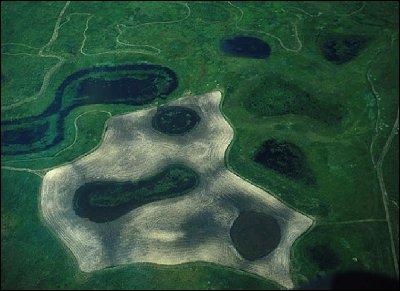
Improving Prairie Pond Counts With Aerial Videography and Global Positioning Systems -- NPWRC developed a method to rapidly assess surface water in prairie wetlands using aerial videography, global positioning systems (GPS), and an optical disk recorder. The method could be used to improve the habitat data collected in the annual Waterfowl Breeding Ground Population and Habitat Surveys conducted by the U.S. FWS and the Canadian Wildlife Service. Capture and organization of the video frames by transect segment was automated using an optical disk recorder and the GPS data. The video image analysis method combined the strengths of digital image processing and visual interpretation. The system enabled a rapid and accurate assessment of the average number of ponds by transect segment, and the video imagery is a valuable source of data for estimating other habitat attributes and analysis of habitat trends. Contact: larry_strong@usgs.gov
National Park Service Vital Signs Monitoring -- The NPWRC Black Hills Field Station is assisting the NPS Northern Great Plains Inventory and Monitoring Network to develop the vegetation component of their long-term “Vital Signs” monitoring plan. The work involves compiling information about the vegetation resources of each of the 13 parks in the network, describing current vegetation monitoring efforts in and around the network parks, working with network and park staff to determine which aspects of vegetation to monitor as indicators of ecosystem health, and developing specific protocols for monitoring those indicators. Contact: asymstad@usgs.gov
Biological Assessment of Refuges as Part of the Comprehensive Conservation Plan Process of the U.S. Fish and Wildlife Service -- Scientists at NPWRC in partnership with FORT are assisting U.S. Fish and Wildlife Service Refuges in their Comprehensive Conservation Planning process. The scientists write biological assessment reports that concentrate on habitat conditions and processes and consult with refuges in the development of habitat-based goals and objectives for Comprehensive Conservation Plans. Contact: murray_laubhan@usgs.gov
Using Fire to Manage Northern Mixed-grass Prairie: A Synthesis -- In recognition of the importance of fire in managing northern grasslands and wetlands, Northern Prairie scientists are building an extensive information base to be used in current and future fire research and land management. The first step in this process is building a searchable Procite database of scientific literature relating to fire ecology and management that focuses on grassland and wetland ecosystems. This living database will serve as a valuable resource for both scientists and land managers, and support the development of new scientific studies. Contact: jane_austin@usgs.gov
Diane L. Larson, Ph.D.
Minnesota Field Station
Northern Prairie Wildlife Research Center
100 Ecology Building
1987 Upper Buford Circle
University of Minnesota
St. Paul, Minnesota 55108
(612) 625-9271
dlarson@biosci.umn.edu
Amy J. Symstad, Ph.D.
South Dakota Field Station
Northern Prairie Wildlife Research Center
Mount Rushmore National Memorial
Building 31, Suite 1
13000 Highway 244
Keystone, South Dakota 57751-0268
(605) 574-3178
asymstad@usgs.gov
Esther D. Stroh
Missouri Field Station
Northern Prairie Wildlife Research Center
373 McReynolds Hall
University of Missouri
Columbia, Missouri 65211
(573) 882-2842
esther_stroh@usgs.gov
 Download this Fact Sheet in PDF format (requires PDF Reader, download free reader) Download this Fact Sheet in PDF format (requires PDF Reader, download free reader) |
April 2004 |
|
U.S. Department of the Interior,
U.S. Geological Survey 8711 37th Street SE, Jamestown, North Dakota 58401, USA URL: http://www.npwrc.usgs.gov Contact: npwrc@usgs.gov Site Last Updated: October 14, 2004 Privacy Statement | Disclaimer | FOIA | Accessibility |

|